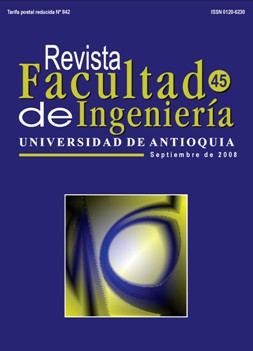Wood Density in Eucalyptus clones by X-Rays Densitometry
DOI:
https://doi.org/10.17533/udea.redin.18116Keywords:
Eucalyptus, X-rays, densitometry, density, clonAbstract
In Brazil, as in many other countries significant advances have been verified in intensive clonal silviculture with remarkable differences on parameters of growth and development between species clones and hybrids of Eucalyptus. At the same time, during recent years the concept of multiple uses of tree logs to increase the yield of the forest enterprise as cellulose and paper and solid wood has been introduced. The present paper studies the wood uniformity index and radial variability of density using x-rays densitometry of 8 year clones Eucalyptus grandis and E. grandis x urophylla in order to optimize their use. This experiment was performent at Suzano Cellulose and Paper Company Clone Plantation in San Miguel de Arcanjo-SP-Brazil. The best five clones of the species and hybrid by their silviculture characteristics were selected. Three models of radial density variation were found and the formation of three different types of wood were characterized (youthful, of transition and adult); the average value of wood apparent density in clones was 0.46 and 0.54 g/cm3 for Eucalyptus grandis and E. grandis x urophylla, respectively.
Downloads
References
H. Schmitz. “Collective Efficiency: Growth Path for Small-Scale Industry”. The Journal of Development Studies. Vol.31.1995. pp.529-566. DOI: https://doi.org/10.1080/00220389508422377
A. C. B. Amaral. Implantação da metodología de densitometria de raios X em madeira. Piracicaba. Dissertação (Mestrado) – Escola Superior de Agricultura Luiz de Queiroz, Universidade de São Paulo. 1994. pp. 155.
J. T. S. Oliveira. Caracterização da madeira de eucalipto para a construção civil. Tese (Doutorado) – Escola Politécnica, Universidade de São Paulo. São Paulo, 1997. pp. 429.
J. T. S. Oliveira. “O potencial do eucalipto para a produção de madeira sólida”. Revista da Madeira. Vol.75. 2003. pp. 1 – 8.
J. C. Silva. “Influência dos tratamentos silviculturais na qualidade da madeira”. Revista da Madeira. Vol.75. 2003. pp. 1 – 10.
J. C. Silva. Caracterização da madeira de E. grandis de diferentes idades, visando a sua utilização na industria moveleira. Tese (Doutorado)- Universidade Federal de Paraná. Curitiba, 2002. pp.160.
O. F. Ruy. Variação da qualidade da madeira em clones de Eucalyptus urophyll. Dissertação (Mestrado) - Escola Superior de Agricultura Luiz de Queiroz. Universidade de São Paulo. São Paulo, 1998. pp. 69.
J. C. Silva. T. F. Assis. J. T. Oliveira. “Melhoramento genético para a qualidade da madeira”. Revista da Madeira. Vol.75. 2003. pp. 10.
M. Ferreira. “Melhoramento e Silvicultura intensiva clonal”. IPEF. Vol. 45. 1992. pp. 22 – 30.
I. E. Pires, R.C. Paula. “Estado da arte de melhoramento genético florestal para qualidade da madeira”. CRC for temperate hardwood forestry – IUFRO, Salvador, 1997. Anais. Salvador: CRCTHF; IUFRO, 1997. p.7.
M.D.V.Resende. A.R. Higa. “Estratégias de melhoramento para eucaliptos visando a seleção de híbridos”. Curitiba: Boletim de Pesquisa Florestal. Vol.2. 1990. pp. 49-60.
E. Campinhos Jr., C. da-silva Jr. “Desenvolvimento do Eucalyptus do futuro”. Congreso latinoamericano de celulose e papel, 6, São Paulo, 1990. Trabalho convidado, SBS/SBEF, 1990. pp. 55-72.
A. R. Griffin, J. A. Rivelli. “A comment on clonal eucalypt plantation”. Eucalyptus Improvement and Silviculture. Vol.1. 1993. p. 1 5.
A. C. B. Amaral. T. Filho. “M. Avaliação das características dos anéis de crescimento de Pinus taeda L. segundo a microdensitometria de raios X”. Revista de Ciência e Tecnologia. Vol. 6. 1998. pp. 17 – 23.
R. M. Echols. “Uniformity of wood density assessed from X-rays of increment cores”. Wood Science and Technology. Vol. 7. 1973. pp. 34-44. DOI: https://doi.org/10.1007/BF00353377
Downloads
Published
How to Cite
Issue
Section
License
Revista Facultad de Ingeniería, Universidad de Antioquia is licensed under the Creative Commons Attribution BY-NC-SA 4.0 license. https://creativecommons.org/licenses/by-nc-sa/4.0/deed.en
You are free to:
Share — copy and redistribute the material in any medium or format
Adapt — remix, transform, and build upon the material
Under the following terms:
Attribution — You must give appropriate credit, provide a link to the license, and indicate if changes were made. You may do so in any reasonable manner, but not in any way that suggests the licensor endorses you or your use.
NonCommercial — You may not use the material for commercial purposes.
ShareAlike — If you remix, transform, or build upon the material, you must distribute your contributions under the same license as the original.
The material published in the journal can be distributed, copied and exhibited by third parties if the respective credits are given to the journal. No commercial benefit can be obtained and derivative works must be under the same license terms as the original work.










 Twitter
Twitter